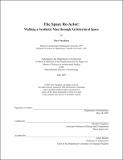| dc.contributor.advisor | Takehiko Nagakura. | en_US |
| dc.contributor.author | Narahara, Taro | en_US |
| dc.contributor.other | Massachusetts Institute of Technology. Dept. of Architecture. | en_US |
| dc.date.accessioned | 2007-10-22T16:31:23Z | |
| dc.date.available | 2007-10-22T16:31:23Z | |
| dc.date.copyright | 2007 | en_US |
| dc.date.issued | 2007 | en_US |
| dc.identifier.uri | http://hdl.handle.net/1721.1/39255 | |
| dc.description | Thesis (S.M.)--Massachusetts Institute of Technology, Dept. of Architecture, 2007. | en_US |
| dc.description | This electronic version was submitted by the student author. The certified thesis is available in the Institute Archives and Special Collections. | en_US |
| dc.description | Leaf 85 blank. | en_US |
| dc.description | Includes bibliographical references (leaves 82-83). | en_US |
| dc.description.abstract | Spatial qualities in architectural design cannot be fully evaluated solely by observing geometrical constructs without reference to inhabitants placed inside. However, imagining what happens to those inhabitants and appreciating their movement is difficult even for trained architects. This thesis proposes a computational method for visualizing animated human reactions to physical conditions that are described in a synthetic architectural model. Its goal is to add a sense of place to the geometry, and augment the representation of its spatial quality for designers and audience. The proposed method introduces a walking scale figure in a geometric model. Through agent-based computation, it moves inside the model and displays various behaviors in reaction to spatial characteristics such as transparent surface, opaque surface, perforation and furniture. The figure is assigned a psychological profile with a different degree of sociability, and reacts to proximity and visibility of others in the same model. Today's advanced computational design tools can produce complex forms and sophisticated visualizations of light, materials and geometry. But they are not suitable for helping people to quickly study and understand a spatial design as it would be inhabited. The proposed method lays a foundation for developing a new kind of software that overcomes this shortcoming. | en_US |
| dc.description.statementofresponsibility | by Taro Narahara. | en_US |
| dc.format.extent | 85 leaves | en_US |
| dc.language.iso | eng | en_US |
| dc.publisher | Massachusetts Institute of Technology | en_US |
| dc.relation.requires | DVD-ROM contains files in .mov, .wmv, .pdf and .html files. | en_US |
| dc.rights | M.I.T. theses are protected by copyright. They may be viewed from this source for any purpose, but reproduction or distribution in any format is prohibited without written permission. See provided URL for inquiries about permission. | en_US |
| dc.rights.uri | http://dspace.mit.edu/handle/1721.1/7582 | |
| dc.subject | Architecture. | en_US |
| dc.title | The Space Re-Actor : walking a synthetic man through architectural space | en_US |
| dc.type | Thesis | en_US |
| dc.description.degree | S.M. | en_US |
| dc.contributor.department | Massachusetts Institute of Technology. Department of Architecture | |
| dc.identifier.oclc | 173318775 | en_US |
